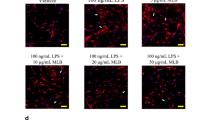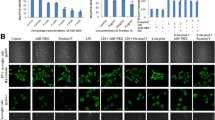Abstract
Salviae miltiorrhizae Radix (SMR), an eminent herb in the treatment of cardiovascular disorder (called blood stasis in traditional Chinese medicine), is widely used in China, Japan, Taiwan and Korea. SMR is also herbal medicines used in the treatment of drug addiction without scientific support for their mechanism of action. We evaluated the effect of SMR on superoxide production by rat microglias using a 2-methyl-6-(p-methoxyphenyl)-3,7-dihydroimidazo[1,2-a]pyrazin-3-one-dependent chemiluminescence assay. SMR dose-dependently inhibited superoxide production by microglias stimulated with phorbol myristate acetate or opsonized zymosan, while it had no effect on superoxide production by a hypoxanthine-xanthine oxidase system. These results indicate that SMR does not have a scavenging effect, but has an inhibitory effect on superoxide generation by microglias. Although SMR is commonly used for treating chronic cerebral infarction, it may also have a protective effect on progression of Parkinson's disease or Alzheimer's disease. On the other hand, the present study investigated the effect of the medicinal plant on dopaminergic neurotransmission in comparison with amphetamine. The effect of crude water extracts (0.1 g/ml) of SMR on K+(20 mM)-stimulated dopamine release from rat striatal slices was compared with amphetamine (10−4 M) using high-performance liquid chromatography with electrochemical detection to measure endogenous dopamine. Amphetamine and SMR significantly increased K+-stimulated dopamine release (P < 0.001) from rat striatal slices when compared with K+-stimulated alone. SMR potentiated the effect of amphetamine on K+-stimulated dopamine release (P < 0.001) when compared with amphetamine alone. The results indicate that SMR may stimulate dopamine release in the same manner as amphetamine. It remains to be determined whether the effect of this extract on dopamine function is important in its therapeutic use in the treatment of drug addiction.
Similar content being viewed by others
REFERENCES
Li, H. B., Lai, J. P., Jiang, Y., and Chen F. 2002. Preparative isolation and puri cation of salvianolic acid B from the Chinese medicinal plant Salvia miltiorrhiza by high-speed counter-current chromatography. J. Chromatogr. A. 943:235-239.
Liu, J., Shen, H. M., and Ong, C. N. 2001. Role of intracellular thiol depletion, mitochondrial function and reactive oxygen species in Salvia miltiorrhiza-induced apoptosis in human hepatoma HepG2 cells. Life Sci. 69:1833-1850.
Hsieh, M. T., Peng, W. H., Wu, C. R., and Wang, W. H. 2000. The ameliorating effects of the cognitive-enhancing Chinese herbs on scopolamine-induced amnesia in rats. Phytother. Res. 14:375-377.
Jie, X. Y., Tan, B. K., and Zhu, Y. Z. 2000. Salvia miltiorrhiza and ischemic diseases. Acta Pharmacol. Sin. 21:1089-1094.
Jung, H. S. 2002. Radix Salviae Miltiorrahizae extract (Salvia miltiorrhia BGE)(SME)protects rat pheochromocytoma cells against hydrogen peroxide-induced injury. Department of Oriental Medicine, Graduate School of Dongguk University, Kyungju, Korea. Thesis for Master 's degree.
Kwon, T. S. 2003. Inhibitory effect of Salviae miltiorrhizae Radix on superoxide generation by activated rat microglias. Department of Oriental Medicine, Graduate School of Dongguk University, Kyungju, Korea. Thesis for Ph. D. degree.
Jiangsu New Medical College (Ed. ). 1977. Dictionary of Chinese Materia Medica. Science and Technology Press of Shanghai, Shanghai.
Colton, C. A., Chernyshev, O. N., Gilbert, D. L., and Vitek, M. P. 2000. Microglial contribution to oxidative stress in Alzheimer 's disease. Ann. N. Y. Acad. Sci. 899:292-307.
Grundke-Iqbal, I., Fleming, J., Tung, Y. C., Lassmann, H., Iqbal K., and Joshi J. G. 1990. Ferritin is a component of the neuritic (senile)plaque in Alzheimer dementia. Acta Neuropathol. 81:105-110.
Kurkowska-Jastrzebska, I., Wronska, A., Kohutnicka, M., Czlonkowski, A., and Czlonkowska, A. 1999. MHC class II positive microglia and lymphocytic in ltration are presentin the substantia nigra and striatum in mouse model of Parkinson 's disease. Acta Neurobiol. Exp. 59:1-8.
McGeer, P. L., Itagaki, S., Boyes, B. E., and McGeer, E. G. 1988. Reactive microglia are positive for HLA-DR in the substantia nigra of Parkinson's and Alzheimer's disease brains. Neurology 3:1285-1291.
Van Muiswinkle, F. L., Veerhuis, R., and Eikelenboom, P. 1966. Amyloid protein primes cultured rat microglial cells for an enhanced phorbol 12-myristate 13-acetate-induced respiratory burst activity. J. Neurochem. 66:2468-2476.
Yoshida T., Tanaka, M., Sotomatsu, A., and Okamoto, K. 1998. Activated microglia cause iron-dependent lipid peroxi-dation in the presence of ferritin. Neuro Report 9:1929-1933.
Battaglia, A., Bruni, G., Ardia, A., and Sachetti, G. On behalf of the Italian Nicergoline Study Group, Nicergoline Study Group. 1999. Nicergoline in mild to moderate dementia. A multicenter, double-blined, placebo-controlled study. J. Am. Geriatr. Soc. 37:295-302.
Saletu, B., Paulus, E., Lizmayer, L., Anderer, P., Semlitsch, H. V., Grunberger, J., Wicke, L., Neuhold, A., and Podreka, I. 1995. Nicergoline in senile dementia of Alzheimer type and multi-infarct dementia or double-blind, placebo-controlled, clinical and EEG/ERP mapping study. Psychopharmacology 117:385-395.
Groo, D., Palosi, E., and Szporny, L. 1989. Cognitive enhancers prevent the hypoxia-induced disruption of conditioned avoidance response. Drug Dev. Res. 18:19-28.
Matsuoka, Y., Fukushima, T., Iwata, H., Matsumoto, M., Shibutani, Y., Kawashima, K., Kudo, Y., and Ishida, R. 1990. Inhibitory action of nicergoline and its metabolites on acetylcholinesterase activity in rats and mouse brain. Adv. Behav. Biol. 38B:415-419.
Ogawa, N., Asanuma, M., Hirata, H., Kondo, Y., Kawada, Y., and Mori, A. 1993. Cholinergic deficits in aged rat brain are corrected with nicergoline. Arch. Gerontol. Geriatr. 16:103-110.
Rice-Evans, C. A., Miller, N. J., and Paganga, G. 1996. Structure-antioxidant activity relationship of flavonoids and phenolic acids. Free Radic. Biol. Med. 20:933.
Kim, J. W. 1998. Effects of Magnesium Lithospermate B from Salvia miltiorrhiza on Hepatic Antioxidant System in Senescence Accelerated Mouse (SAM-R/I). Kor. J. Gerotol. 8(1):83-89.
Ahn, B. Y. 1999. Mutagenic Effect of Tansen (Salvia miltiorrhiza Bge). Kor. J. Appl. Microbiol. Biotechnol. 27(3):197-202.
Kim, S. B. 1998. Protective effect of Salviae-radix extraction in H2O2 induced renal cell injury. The Journal of Korean Oriental Medical Society, 19:38-48.
Lim, B. S. 2002. Effect of Salviae Radix extract on chemical hypoxia-induced cell death in human glioma cells. Department of Oriental Medicine, Graduate School of Dongguk University. Thesis for Doctor's degree. Kyungju, Korea.
Sun, J. 2002. Effect of natural products on ischemic heart dis-eases and cardiovascular system. Acta Pharmaco Sin. 23(12):1142-1151.
Cao, E. H., Liu, X. Q., Wang, J. J., and Xu, N. F. 1996. Effect of natural antioxidant tanshinone II-A on DNA damage by lipid peroxidation in liver cells. Free Radic Biol Med. 20(6):801-806.
Xing, Z. Q., Zeng, X. C., and Yi, C. T. 1996. Effect of Salvia miltiorrhiza on serum lipid peroxide, superoxide dismutase of the patients with coronary heart disease. Chung Kuo Chung Hsi I Chieh Ho Tsa Chih 16(5):287-288.
Gu, Z. P., Ma, C. X., and Zhang, B. X. 1994. The effects of injection salviae miltiorrhizae in preventing and treating fat embolism syndrome. Chung Hua Wai Ko Tsa Chih 32(11):692-695.
Yu, S., Kuang, P., Kanazawa, T., Onodera, K., Metoki, H., and Oike, Y. 1998. The effects of radix Salviae miltiorrhizae on lipid accumulation of peroxidized low density lipoprotein in mouse peritoneal macrophages-lipid analysis and morpho-logical studies. J. Trad. Chin. Med. 18(4):292-299.
Zhang, P. T., Chen, Z. R. 1994. Effect of Salvia miltiorrhiza on lipid peroxidation antioxidant enzymes activity in patients with chronic cor pulmonale. Chung Kuo Chung Hsi I Chieh Ho Tsa Chih 14(8):474-477.
Zhao B. L., Jiang, W., Zhao, Y., Hou, J. W., and Xin, W. J. 1996. Scavenging effects of salvia miltiorrhiza on free radicals and its protection for myocardial mitochondrial membranes from ischemia-reperfusion injury. Biochem. Mol. Biol. Int. 38(6):1171-1182.
Kuang P., Tao, Y., and Tian, Y. 1996. Radix Salviae mil-tiorrhizae treatment results in decreased lipid peroxidation in reperfusion injury. J. Trad. Chin. Med. 16(2):138-142.
Wei, X. D., Li, L., and Bai, J. 1997. Effect of Salvia miltiorrh-izae Composita on erythrocyte membrane phospholipid in patients with coronary heart disease. Chung Kuo Chung Hsi I Chieh Ho Tsa Chih 17(6):336-338
Yang, D. P. 1992. Prevention of reperfusion injury of an ischemic. ap, an experimental study. Chung Hua Cheng Hsing Shao Shang Wai Ko Tsa Chih 8(3):216-217.
Tanaka, M., Sotomatsu, A., Yoshida, T., Hirai, S., and Nishida, A. 1994. Detection of superoxide production by activated microglia using a sensitive and speci c chemiluminescence assay and microglia-mediated PC12h cell death. J. Neurochem. 63:266-270.
Nakano, M., Sugioka, K., Ushijima, Y., and Goto, T. 1986. Chemiluminescence probe with Cypridina luciferin analog, 2-methyl-6-phenyl-3, 7-dihydroimidazo [1, 2-a ]pyrazin-3-one, for estimating the ability of human granulocytes to generate O2-. Anal. Biochem. 159:363-369.
Nishida, A., Kimura, H., Nakano, M., and Goto, T. 1989. A sensitive and speci c chemiluminescence method for estimat-ing the ability of human granulocytes and monocytes to generate O2-. Clin. Chim. Acta 179:177-181.
Suzumura, A., Mezitis, S. G. E., Gonatas, N. K., and Silberberg, D. H. MHC antigen expression on bulk isolated macro-phage-microglia from newborn mouse brain:induction of Ia antigen expression by interferon. J. Neuroimmunol. 15(1987):263-278.
Bennett, G. W., Sharp, T., Marsden, C. A., and Parker, T. L. 1983. A manually-operated brain tissue slicer suitable for neurotransmitter release studies. J. Neurosci. Methods 7:107-115.
Yoshida, T., Tanaka, M., and Okamoto, K. 2001. Inhibitory effect of nicergoline on superoxide generation by activated rat microglias measured using a simple chemiluminescence method. Neuroscience Letters 297:5-8.
Leshner, A. I. and Koob, G. F. 1999. Drugs of abuse and the brain. Proc. Assoc. Am. Physicians 111:99-108.
Roothman, R. B., Elmer, G. I., Shippenberg, T. S., Rea, W., and Baumann, M. H. 1998. Phentermine and fen. uramine. Preclinical studies in animal models of cocaine addiction. Ann. New York Acad. Sci. 844:59-74.
Shafer, R. A. and Levant. B. 1998. The D3 dopamine receptor in cellular and organismal function. Psychopharmacology (Berl.) 135:1-16.
Routledge, L. T., Ashmeade, T., and Taylor, S. 1996. Elucidation of D3 receptor function in vivo:do D3 receptors mediate inhibition of dopamine neuronal activity?. Biochem. Soc. Trans. 24:199-201.
Wood, M. D., Boyfield, I., Nash, D. J., Jewitt, F. R., Avenell, K. Y., and Riley, G. J. 2000. Evidence for antagonist activity of the dopamine D3 receptor partial agonist, BP 897, at human dopamine D3 receptor. Eur. J. Pharmacol. 407:47-51.
Author information
Authors and Affiliations
Rights and permissions
About this article
Cite this article
Koo, BS., Kwon, TS. & Kim, CH. Salviae miltiorrhizae Radix Inhibits Superoxide Generation by Activated Rat Microglias and Mimics the Action of Amphetamine on in vitro Rat Striatal Dopamine Release. Neurochem Res 29, 1837–1845 (2004). https://doi.org/10.1023/B:NERE.0000042210.72927.ec
Issue Date:
DOI: https://doi.org/10.1023/B:NERE.0000042210.72927.ec




